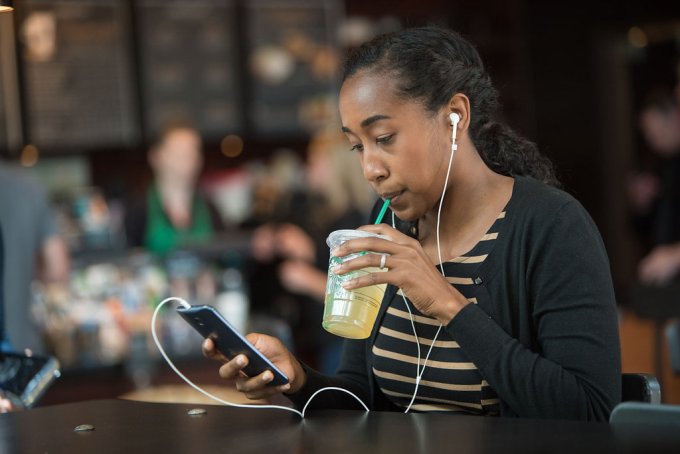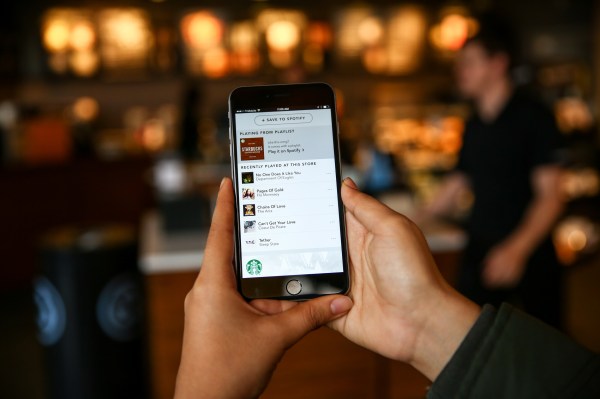Starbucks and streaming service Spotify are expanding their relationship today with the launch of a new digital music experience for Starbucks customers which will allow them to identify songs being played in stores, then download and save those they like to a playlist on Spotify’s app.
The feature, which ultimately aims to boost both Starbucks Mobile App usage and sign-ups for Spotify’s music service, will go live today at the over 7,500 company-operated stores in the U.S., where it will be available to the coffee chain’s customers, including its 10 million My Starbucks Rewards loyalty members, as well as Spotify’s U.S. user base.
Music, of course, has long been an important part of the Starbucks brand and culture, with the company in the past giving away free tracks from iTunes along with their lattés. In addition, Starbucks began a program in 1994 to select original CDs to sell in store, including those from artists like John Lennon, Aretha Franklin, Bonnie Raitt and others. It has also sold seasonal CDs, and “Artist Choice” CDs which featured favorites from big names like Bob Dylan, Yo-Yo Ma, the Rolling Stones, and Ray Charles.

As you may recall, Spotify and Starbucks first announced a formal partnership back in May 2015 which saw Spotify becoming the lead music partner for Starbucks. As a part of the deal, baristas were set up with Premium subscriptions to the music service so they could help pick the songs played in their location. The company says this is now underway, with baristas and other employees creating “Store Favorites” playlists.
The idea, Starbucks said in May, was to allow customers using the Starbucks Mobile App to stream the store’s playlist from their device.
Today, the music played in the stores will become even more accessible. Going forward, Spotify members – both free and paid – will be able to save the store’s music to a playlist within the Spotify mobile application itself.
In order to do so, however, they’ll still need to first launch Starbucks’ mobile app, the company explains.
[gallery ids="1264566,1264564,1264567,1264568,1264565"]
When that app is launched in a participating store, customers will be able to view a “Now Playing” section as well as a “Recently Played” section where they can browse through tracks and choose those they want to save. From here, customers can also choose to “love” a song to influence the store’s future playlist selections, share a song on social media services, or play it on Spotify.
That latter option will allow Spotify users to continue to access the songs, as well as the Starbucks-curated playlists, even after they’ve left the store.
Basically, it’s a tighter integration between Starbucks’ and Spotify’s mobile applications, which allows the coffee chain to be something of a playlist programmer for the Spotify user base.
Music is played in Starbucks stores using PlayNetwork’s CURIO content delivery system, which is an internet-connected device that lets Starbucks employees control the music in their stores using an iPod touch. The Starbucks Mobile App identifies the playlist in the given store which is being played by the CURIO, then shares this information with customers in the app.
Beginning this month, this system will also be utilized to identify and highlight both established and emerging artists, which will power a new weekly feature in the Starbucks App.
All these features will be available on both the iOS and Android version of the Starbucks Mobile App, the company notes.
“Music has played a pivotal role in our stores for over forty years and we have been at the forefront of how to integrate it into a retail environment” said Howard Schultz, Chairman and CEO of Starbucks in a statement. “Today is the next era in that experience. We are merging the physical and digital, providing new access points for Spotify as they continue to grow globally, placing more control into our customers’ hands and giving artists the world’s largest stage for them to share their talent.”
This is not the first time Spotify has managed to establish its service as the lead music provider for a big, brand-name company. In 2014, the chain also did a deal with Uber that allowed passengers to become backseat DJs, for example. And it partnered with Virgin America to power in-air streaming on flights, works with music festivals like Bonnaroo, as well as auto makers and mobile device manufacturers.
